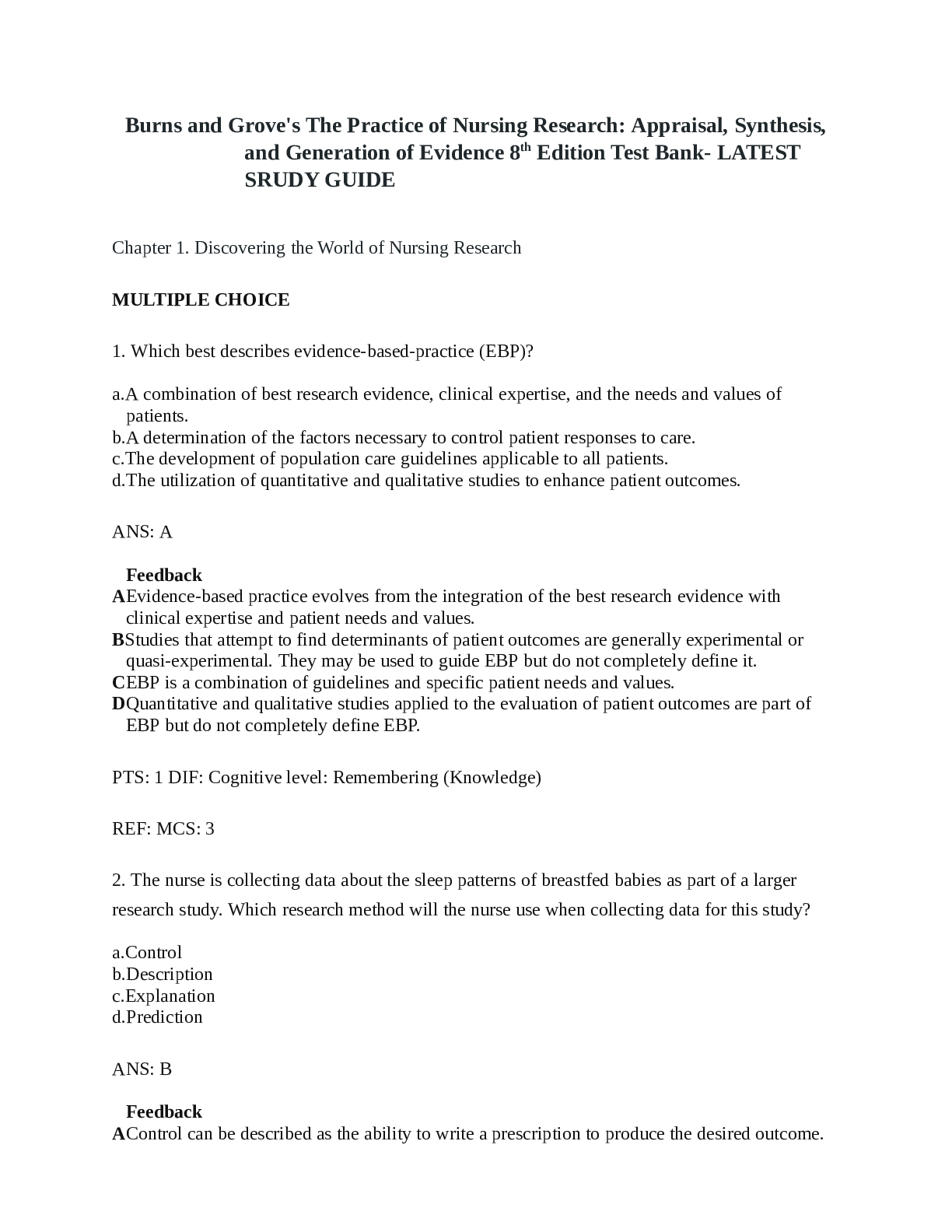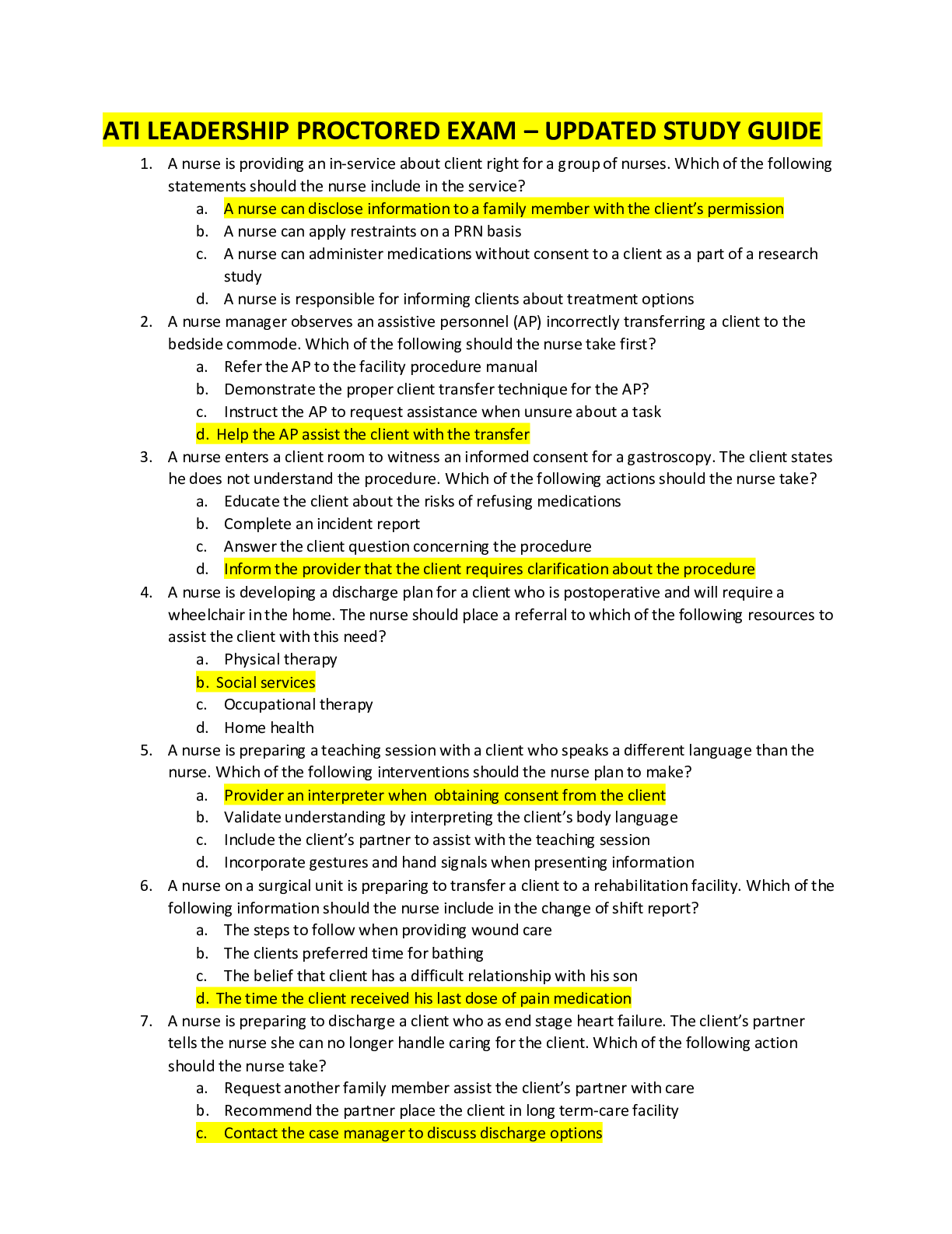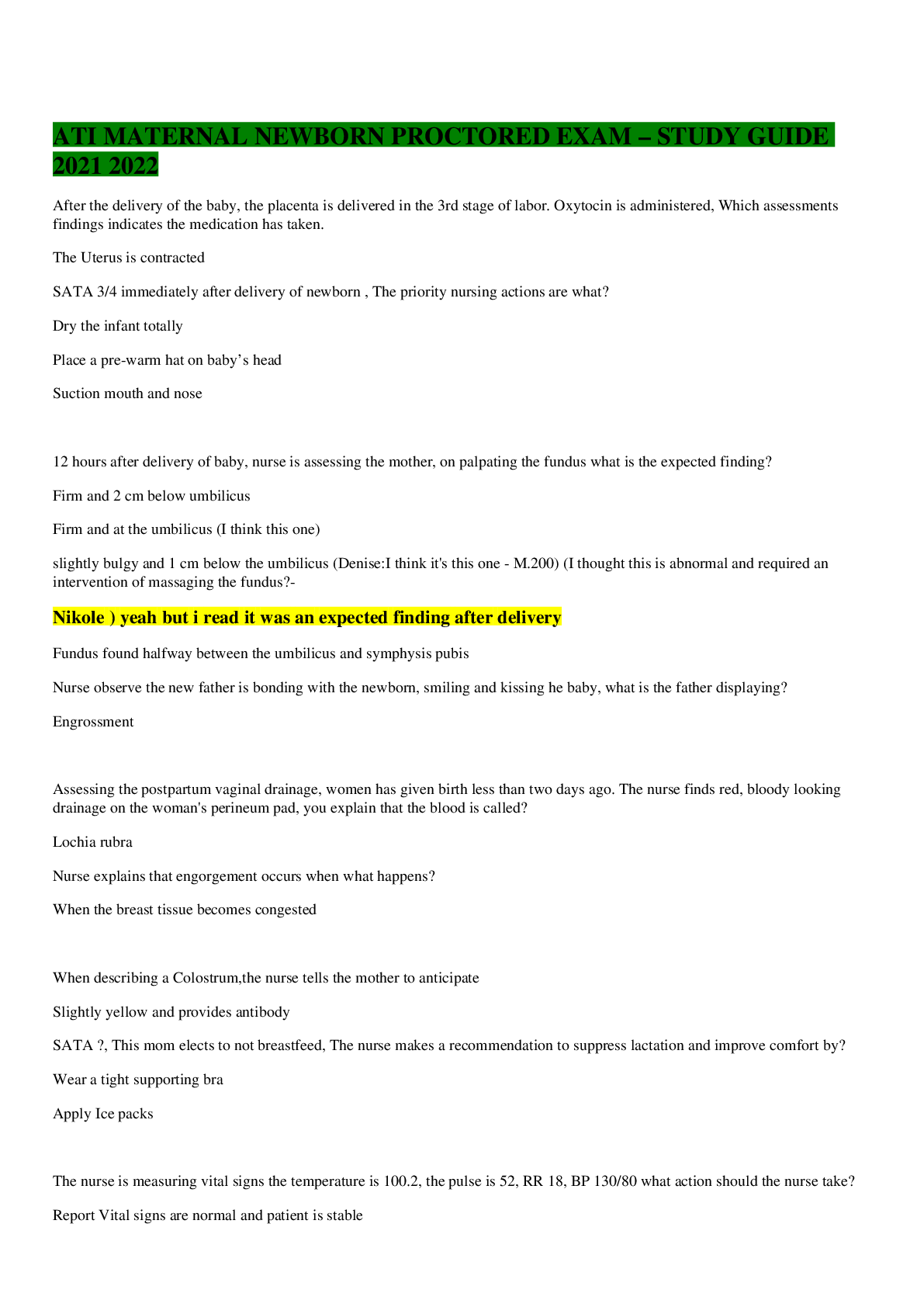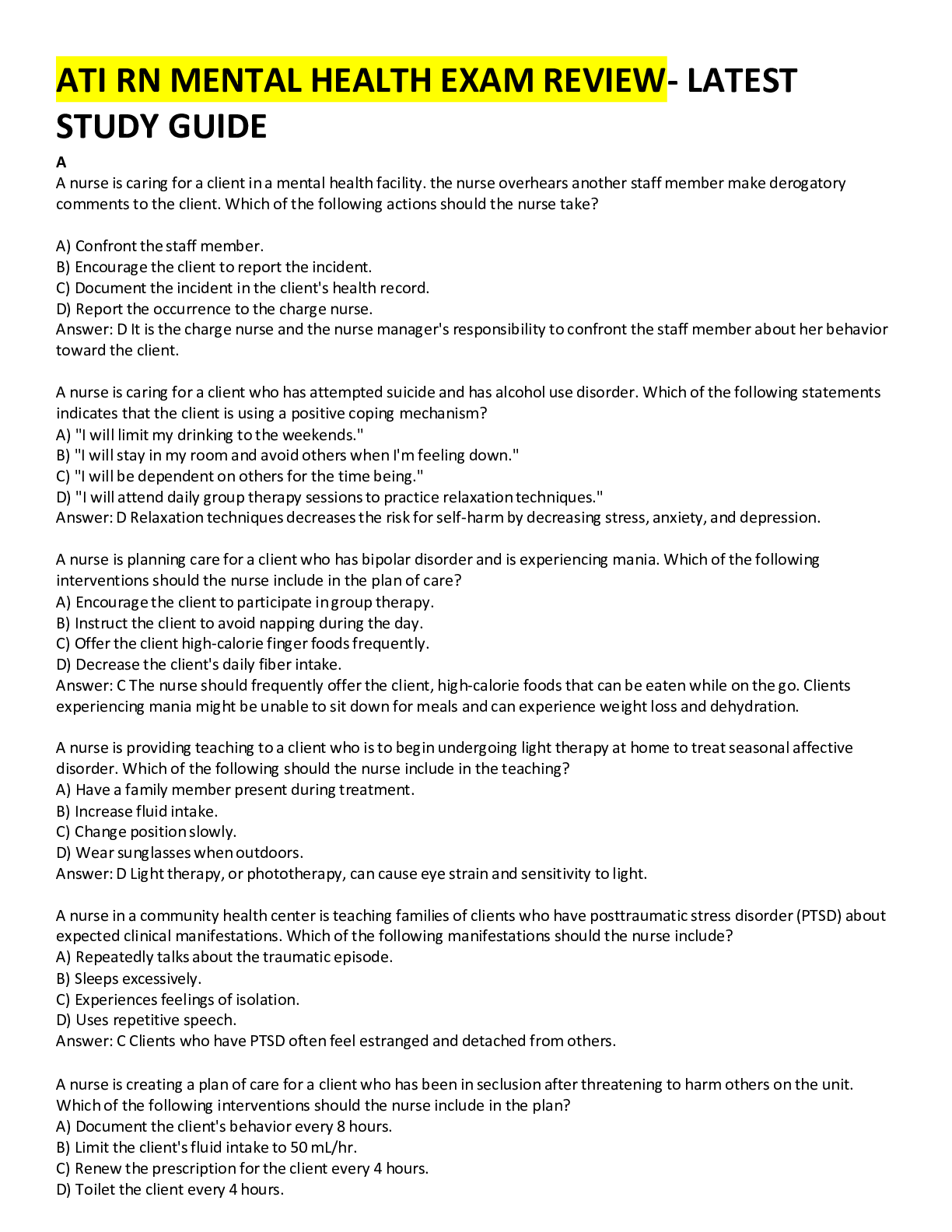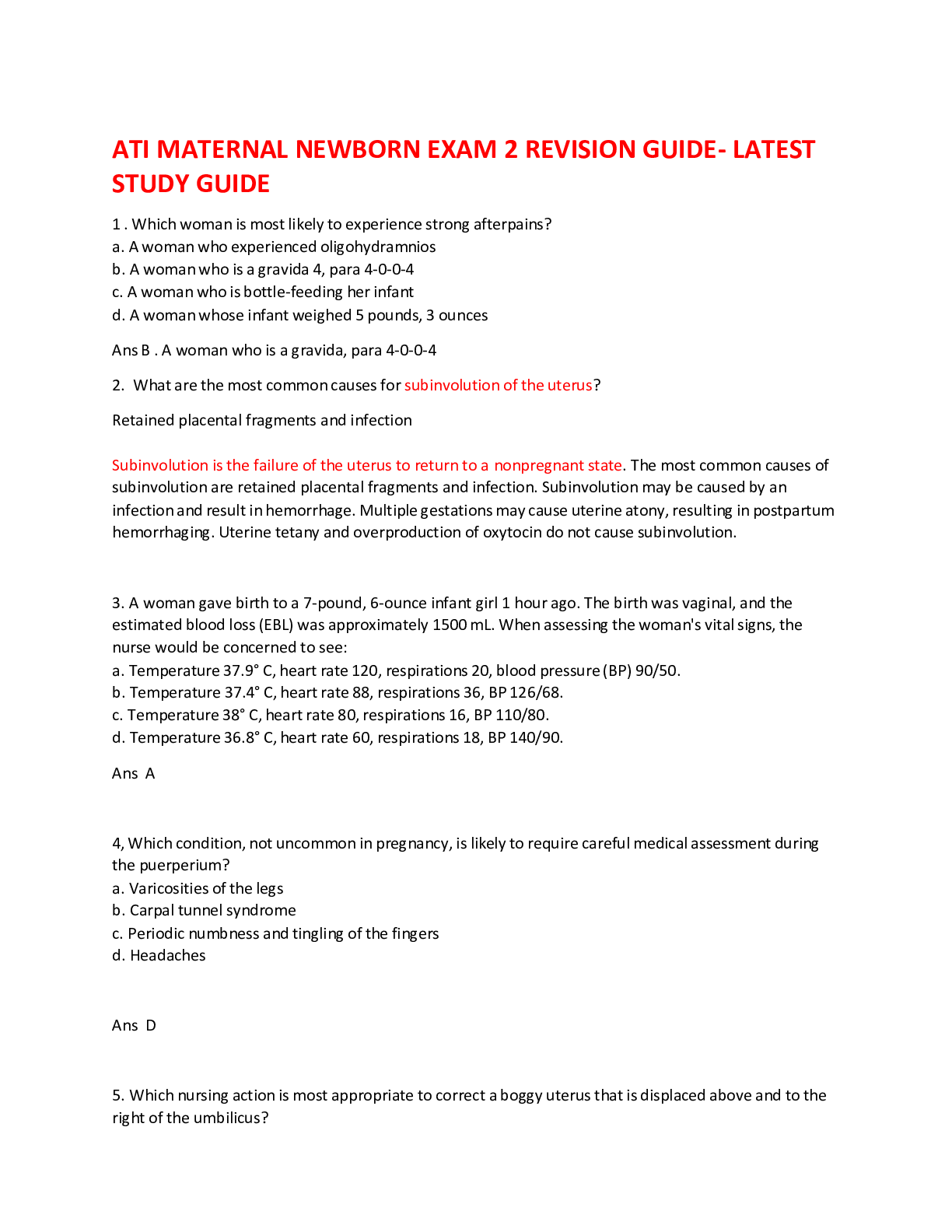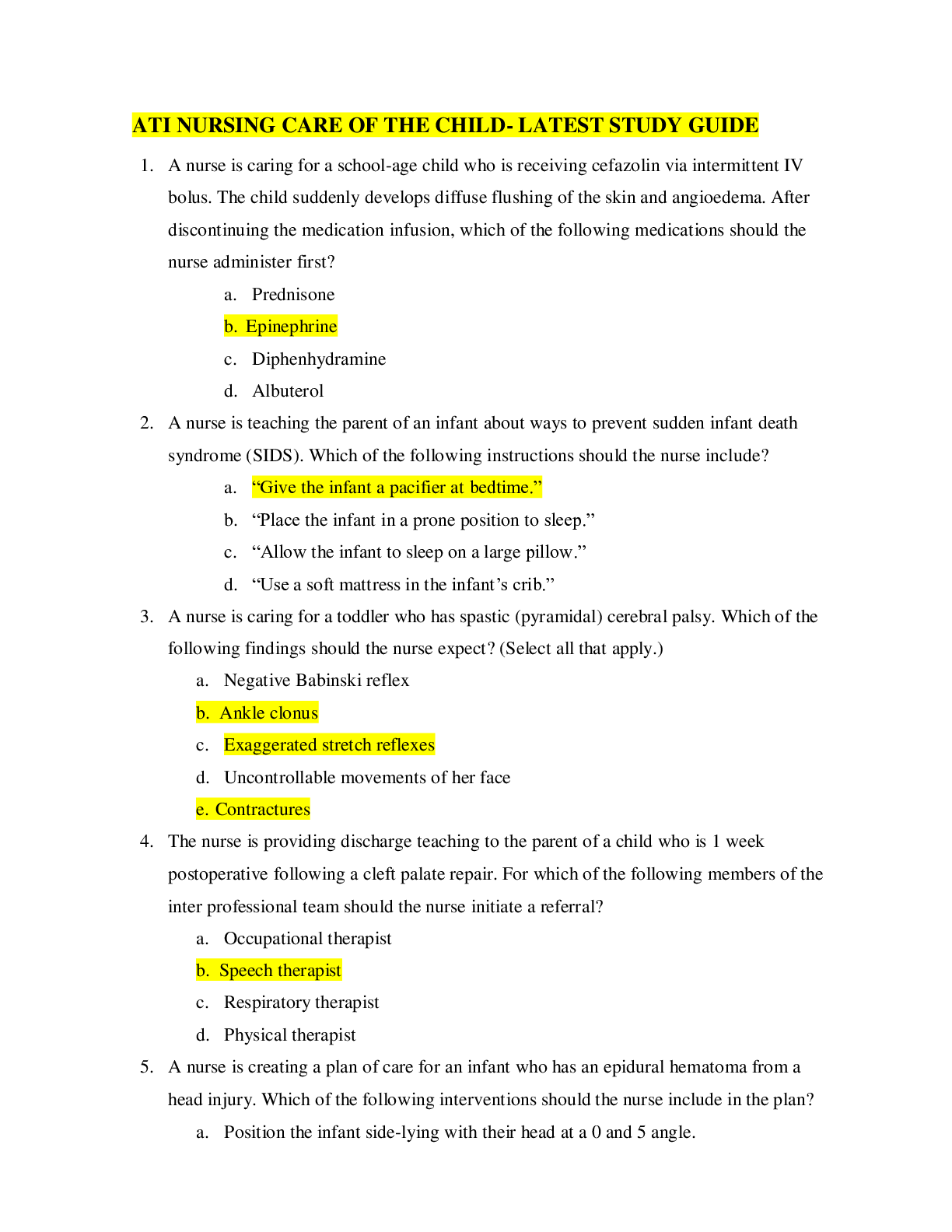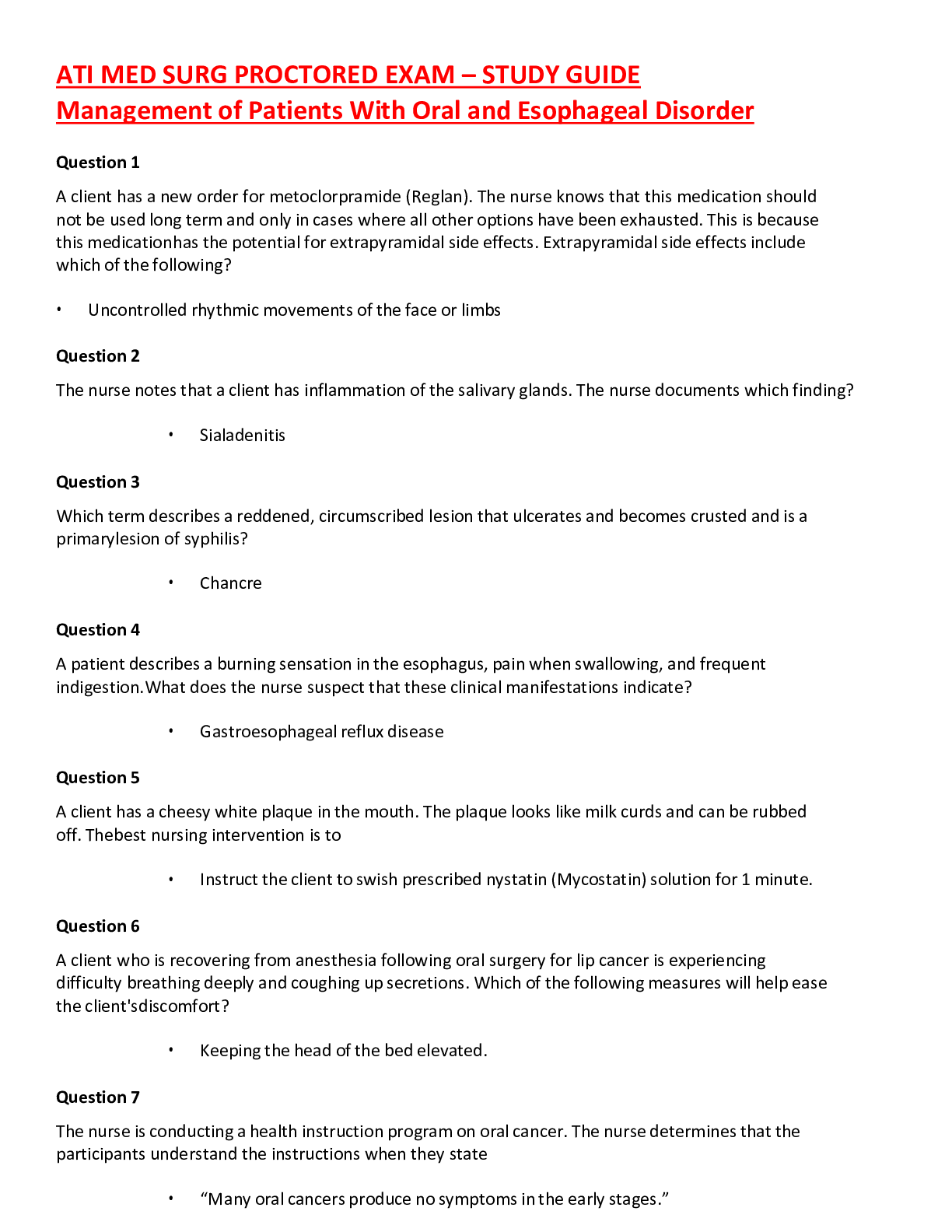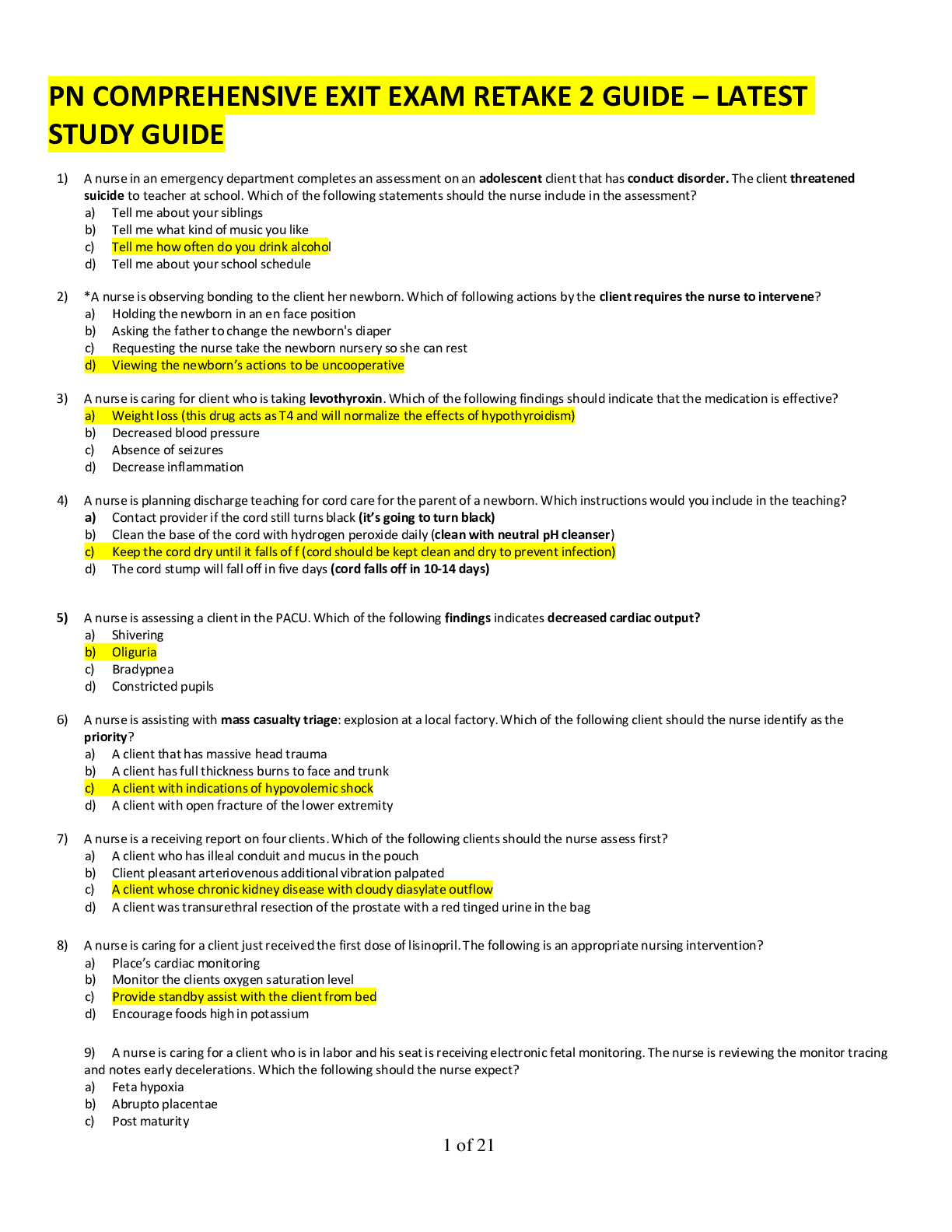*NURSING > STUDY GUIDE > ATI MEDSURG PROCTORED EXAM – LATEST STUDY GUIDE (All)
ATI MEDSURG PROCTORED EXAM – LATEST STUDY GUIDE
Document Content and Description Below
ATI MEDSURG PROCTORED EXAM – LATEST STUDY GUIDE 1. A nurse is collecting data from a client who has emphysema. Which of the following findings should the nurse expect? (Select all that apply.) 1) ... Dyspnea 2) Barrel chest 3) Clubbing of the fingers 4) Shallow respirations INCORRECT 5) Bradycardia Answer Rationale: Dyspnea is correct. Dyspnea is experienced by clients who have emphysema due to inadequate oxygen exchange in the lungs. Barrel chest is correct. The lungs of clients who have emphysema lose their elasticity, and the diaphragm becomes permanently flattened by overdistention of the lungs. The muscles of the rib cage also become rigid, and the ribs flare outward. This produces the barrel chest typical of emphysema clients. Clubbing of the fingers is correct. Air is trapped in the lungs due to their lack of elasticity, which decreases oxygenation. Clubbing results from these chronic low blood- oxygen levels. Shallow respirations is correct. Clients who have emphysema lose lung elasticity; consequently, respirations become increasingly shallow and more rapid. Bradycardia is incorrect. The heart rate will increase as the heart tries to compensate for less oxygen being delivered to the tissues. 2. A nurse is caring for a client who has Cushing's syndrome. Which of the following clinical manifestations should the nurse expect to observe? (Select all that apply.) 1) Buffalo hump 2) Purple striations 3) Moon face INCORRECT 4) Tremors INCORRECT 5) Obese extremities Answer Rationale: Buffalo hump is correct. Cushing's syndrome is a disease caused by an increased production of cortisol or by excessive use of corticosteroids. Buffalo hump, a collection of fat between the shoulders, is a common manifestation of Cushing's syndrome.Purple striations is correct. Purple striations on the skin of the abdomen, thighs, and breasts are a common manifestation of Cushing's syndrome. This is due to the collection of body fat in these areas.Moon face is correct. Moon face is a common manifestation of Cushing's syndrome. Clients who have this manifestation present with a round, red, full face.Tremors is incorrect. Tremors are not a common finding of Cushing's syndrome.Obese extremities is incorrect. Clients who have Cushing's syndrome have truncal obesity, a protuberant abdomen, with thin extremities, which is due to an alteration in protein metabolism. 3. A nurse is assisting with the care of a client immediately following a lumbar puncture. Which of the following actions should the nurse take? (Select all that apply.) 1) Encourage fluid intake. 2) Monitor the puncture site for hematoma. INCORRECT 3) Insert a urinary catheter. INCORRECT 4) Elevate the client’s head of bed. INCORRECT 5) Apply a cervical collar to the client. Answer Rationale: Encourage fluid intake is correct. The nurse should encourage fluids, unless contraindicated, to replace the cerebrospinal fluid that was removed during the procedure and reduce the risk for a headache. Monitor the puncture site for a hematoma is correct. The nurse should monitor and report a hematoma at the insertion site because this can indicate bleeding. Insert a urinary catheter is incorrect. There is no indication for a urinary catheter insertion. Elevate the client’s head of bed is incorrect. The client should remain flat in bed for 1 hr or more to reduce the risk for a headache. Apply a cervical collar to the client is incorrect. There is no indication for a cervical collar for this client. 4. A nurse is reinforcing pre-operative teaching for a client who is scheduled for surgery and is to take hydroxyzine preoperatively. Which of the following effects of the medication should the nurse include in the teaching? (Select all that apply.) 1) Decreasing anxiety 2) Controlling emesis INCORRECT 3) Relaxing skeletal muscles INCORRECT 4) Preventing surgical site infections 5) Reducing the amount of narcotics needed for pain relief Answer Rationale: Decreasing anxiety is correct. The nurse should include that hydroxyzine is an effective antianxiety agent and is used to decrease anxiety in surgical clients as well as in persons with moderate anxiety. Controlling emesis is correct. The nurse should include that hydroxyzine is an effective antiemetic and is used to control nausea and vomiting in pre- and postoperative clients. Relaxing skeletal muscles is incorrect. The nurse should recognize benzodiazepines, such as diazepam (Valium), are used to produce skeletal muscle relaxation. Preventing surgical site infections is incorrect. The nurse should instruct the client that antibiotics administered prior to surgery are used to diminish the risk of surgical site infections; hydroxyzine, an antiemetic, does not have any effect on bacteria. Reducing the amount of narcotics needed for pain relief is correct. Hydroxyzine increases the effects of narcotic pain medications. The nurse should instruct the client that when it is used for surgical clients, narcotic requirements may be significantly reduced. 5. A nurse is reinforcing teaching with a client who has type 2 diabetes mellitus. The nurse determines that teaching has been effective when the client identifies which of the following manifestations of hypoglycemia? (Select all that apply.) INCORRECT 1) Polyuria 2) Blurry vision 3) Tachycardia INCORRECT 4) Polydipsia 5) Sweating Answer Rationale: Polyuria is incorrect. Hyperglycemia causes polyuria. Blurry vision is correct. Manifestations of hypoglycemia include blurry vision, tremors, anxiety, irritability, headache, and hypotension. Tachycardia is correct. Manifestations of hypoglycemia include tachycardia, tremors, anxiety, irritability, headache, and hypotension. Polydipsia is incorrect. Hyperglycemia causes polydipsia. Sweating is correct. Manifestations of hypoglycemia include sweating, tremors, anxiety, irritability, headache, and hypotension. 6. A nurse is collecting data from a client who has an exacerbation of gout. Which of the following findings should the nurse expect? (Select all that apply.) 1) Edema 2) Erythema 3) Tophi 4) Tight skin INCORRECT 5) Symmetrical joint pain Answer Rationale: Edema is correct. Swelling over the affected joints is a classic manifestation of gout. Erythema is correct. Redness over the affected joints is a classic manifestation of gout. Tophi is correct. Tophi are a classic manifestation of gout. They are nodules that form in subcutaneous tissue due to the accumulation of urate crystals. Tight skin is correct. Tight skin over the affected joints is a classic manifestation of gout. Symmetrical joint pain is incorrect. Symmetrical joint pain is a manifestation of rheumatoid arthritis, not gout. 7. A nurse is assisting in the plan of care for a client who had surgery for a bowel obstruction. The client has a nasogastric tube in place. Which of the following actions should the nurse include in the client's plan of care? (Select all that apply.) 1) Perform leg exercises every 2 hr. 2) Encourage hourly use of an incentive spirometer while awake. 3) Document the color, consistency, and amount of nasogastric drainage. INCORRECT 4) Irrigate the nasogastric tube every 4 to 8 hr. INCORRECT 5) Maintain bed rest for 48 hr following surgery. Answer Rationale: Perform leg exercises every 2 hr is correct. Postoperative clients should frequently perform leg exercises, independently or with assistance, to prevent skin breakdown.Encourage hourly use of an incentive spirometer while awake is correct. Postoperative clients should be encouraged to use the incentive spirometer ten times each hour while awake to prevent atelectasis.Document the color, consistency, and amount of nasogastric drainage is correct. Documenting the color, consistency, and amount of nasogastric drainage is appropriate to include in the client's plan of care.Irrigate the nasogastric tube every 4 to 8 hr is incorrect. Following abdominal surgery, the NG tube should not be moved or irrigated unless prescribed by the provider.Maintain bed rest for 48 hr following surgery is incorrect. Maintaining bed rest following surgery should not be included in the plan of care. Early ambulation prevents distention and improves intestinal mobility. 8. A nurse is assisting with discharge teaching for a client who is postoperative following a laryngectomy. Which of the following instructions should the nurse include in the teaching? (Select all that apply.) 1) To aid in swallowing food, tip the chin before swallowing. INCORRECT 2) Avoid using liquid supplements. INCORRECT 3) Include warm foods in your diet because they are easier to swallow. 4) Swallow twice after each bite. INCORRECT 5) Take a sip of water with each bite of food. Answer Rationale: To aid in swallowing food, tip the chin before swallowing is correct. This action decreases the risk of aspiration. Avoid using liquid supplements is incorrect. Following a laryngectomy, the client is at risk for malnutrition. Liquid supplements provide needed protein and calories. Include warm foods in your diet because they are easier to swallow is incorrect.The client should include cold foods in her diet because they are easier to swallow. Swallow twice after each bite is correct. Swallowing once when initially propelling food down the esophagus and a second time (dry swallowing) to fully clear the esophagus of food will decrease the risk of aspirating food left in the esophagus. Take a sip of water with each bite of food is incorrect. This action places the client at risk for aspiration. 9. A nurse is assisting with discharge teaching for a client who is postoperative from a mastectomy including the removal of axillary lymph nodes. Which of the following instructions should the nurse include? (Select all that apply.) INCORRECT 1) Use talcum powder instead of deodorant on the affected side for the first two weeks after surgery. 2) Perform range-of-motion exercises of the affected arm. INCORRECT 3) Avoid lifting arm above shoulder level on the affected side. INCORRECT 4) Wait 72 hr before consuming a regular diet. 5) Elevated the affected arm on a pillow when resting in bed. Answer Rationale: Use talcum powder instead of deodorant on the affected side for the first two weeks after surgery is incorrect. The client should avoid the use of talcum powder and deodorant until the incision is healed. Perform range-of-motion exercises of the affected arm is correct. The client should perform range-of-motion exercises on the affected arm to improve circulation and reduce the risk of lymphedema. Avoid lifting arm above shoulder level on the affected side is incorrect. The client should face a wall with the arms slightly bent and “walk” both arms up the wall as high as possible. Wait 72 hr before consuming a regular diet is incorrect. The client can eat a regular diet 24 hr after surgery. Elevated the affected arm on a pillow when resting in bed is correct. The client should elevate the affected arm to increase circulation and reduce the risk of lymphedema. 10. A client who is postoperative returns to the unit in skeletal traction. When collecting data from the client, the nurse should expect which of the following findings? (Select all that apply.) 1) Redness at the pin sites 2) Warmth at the pin sites INCORRECT 3) Movement of the pins at the insertion sites INCORRECT 4) No drainage from the pin sites INCORRECT 5) Tenting of the skin around the pin sites Answer Rationale: Redness at the pin sites is correct. The nurse should expect the client to have redness at the pin sites, as it is a manifestation of the expected reaction after insertion. Warmth at the pin sites is correct. The nurse should expect the client to have warmth at the pin sites, as it is a manifestation of the expected reaction after insertion. Movement of the pins at the insertion sites is incorrect. The nurse should report movement of the pins to the surgeon immediately, as it is a manifestation of infection. No drainage from the pin sites is incorrect. Up to 72 hr after surgery, serosanguineous drainage from the pin sites can be heavy; therefore, it is important to clean the pin sites daily. Tenting of the skin around the pin sites is incorrect. The nurse should report tenting to the surgeon immediately, as it is a manifestation of infection. 11. A nurse is reinforcing teaching about dietary recommendations for a client who has a hiatal hernia. Which of the following client statements indicate understanding of the teaching? (Select all that apply.) INCORRECT 1) "I will lie down for one half hour after meals." 2) "I will consume less caffeine and spicy foods." 3) "I will sleep with the head of my bed elevated." 4) "I will try not to gain weight." INCORRECT 5) "I will drink less fluid." Answer Rationale: “I will lie down for one half hour after meals.” is incorrect. A client who has a hiatal hernia should remain upright for at least 1 hr after meals and preferably for several hours. “I will consume less caffeine and spicy foods.” is correct. These foods and beverages can worsen the symptoms of a hiatal hernia. “I will sleep with the head of my bed elevated.” is correct. The client should raise the head of the bed on blocks to avoid lying flat when sleeping. “I will try not to gain weight.” is correct. Obesity raises intra-abdominal pressure and makes the hernia worse. “I will drink less fluid.” is incorrect. Clients should consume adequate and appropriate amounts of fluid, whether or not they have a hiatal hernia. 12. A nurse is collecting data from a client who has an acute myocardial infarction (MI). Which of the following clinical manifestations should the nurse expect to find? (Select all that apply.) INCORRECT 1) Orthopnea INCORRECT 2) Headache 3) Nausea 4) Tachycardia 5) Diaphoresis Answer Rationale: Orthopnea is incorrect. Orthopnea is a manifestation of heart failure, which can develop from a myocardial infarction, but it is not a common manifestation of acute MI. Headache is incorrect. Chest pain and sometimes jaw and shoulder pain, not headache, are classic manifestations of acute MI. Nausea is correct. Nausea and vomiting are classic manifestations of acute MI. Tachycardia is correct. Tachycardia and dysrhythmias are classic manifestations of acute MI. Diaphoresis is correct. Profuse sweating and anxiety are classic manifestations of acute MI. 13.A nurse is reinforcing nutrition teaching for a client who has chronic kidney disease about limiting foods high in potassium. Which of the following foods should the nurse instruct the client to avoid? (Select all that apply). 1) Orange juice INCORRECT 2) Watermelon 3) Bananas INCORRECT 4) Corn flakes cereal INCORRECT 5) White rice Answer Rationale: Orange juice is correct. Orange juice is high in potassium; 240 mL (8 oz) contains 496 mg of potassium Watermelon is incorrect. Watermelon is low in potassium; 152 g (1 cup) of diced watermelon contains 170 mg of potassium. Bananas is correct. Bananas are high in potassium; one medium banana contains 422 mg of potassium. Corn flakes cereal is incorrect.Corn flakes cereal is low in potassium; 34 g (1 cup) of corn flakes cereal contains 60 mg of potassium. White rice is incorrect. White rice is low in potassium; 158 g (1 cup) of cooked white rice contains 55 mg of potassium. 14.A nurse is reinforcing nutrition teaching to a client who has chronic kidney disease about limiting foods high in phosphorus. Which of the following foods should the nurse instruct the client to avoid? (Select all that apply). 1) Milk 2) Sunflower seeds INCORRECT 3) Orange juice INCORRECT 4) Frozen kale 5) Poultry Answer Rationale: Milk is correct. All animal products, including dairy, are a source of phosphorus and should be avoided by a client who is on a phosphorus restricted diet. Sunflower seeds is correct. Sunflower seeds are a food source high in phosphorus and should be avoided by a client who is on a phosphorus restricted diet. Orange juice is incorrect. Orange juice is not a food source high in phosphorus and is safe for clients on a phosphorus restricted diet. Frozen kale is incorrect. Frozen kale is not a food source high in phosphorus and is safe for clients on a phosphorus restricted diet. Poultry is correct. All animal products, including poultry, are a source of phosphorus and should be avoided by a client who is on a phosphorus restricted diet. 15.A nurse is assisting in the plan of care for a client who is scheduled to have a renal biopsy. Which of the following actions should the nurse include in the plan? (Select all that apply). 1) Collect a urine specimen prior to the procedure. 2) Obtain an informed consent prior to the procedure. INCORRECT 3) Administer diphenhydramine prior to the procedure. INCORRECT 4) Maintain a clear liquid diet 4 hr prior to the procedure. 5) Complete coagulation studies prior to the procedure. CONTINUED..............DOWNLOAD FOR BEST REVISION GUIDE AND SCORES [Show More]
Last updated: 1 year ago
Preview 1 out of 45 pages
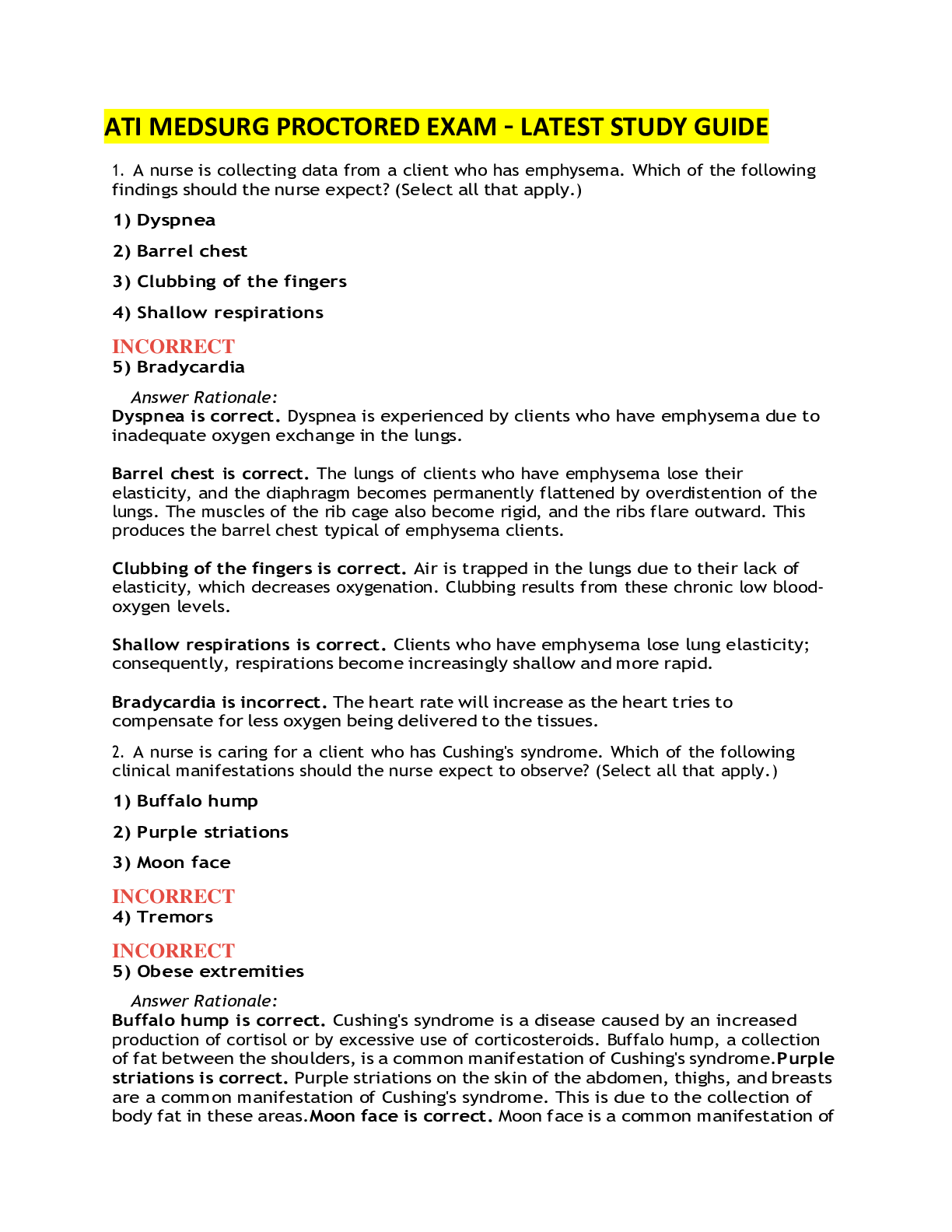
Reviews( 0 )
Document information
Connected school, study & course
About the document
Uploaded On
May 04, 2022
Number of pages
45
Written in
Additional information
This document has been written for:
Uploaded
May 04, 2022
Downloads
0
Views
45

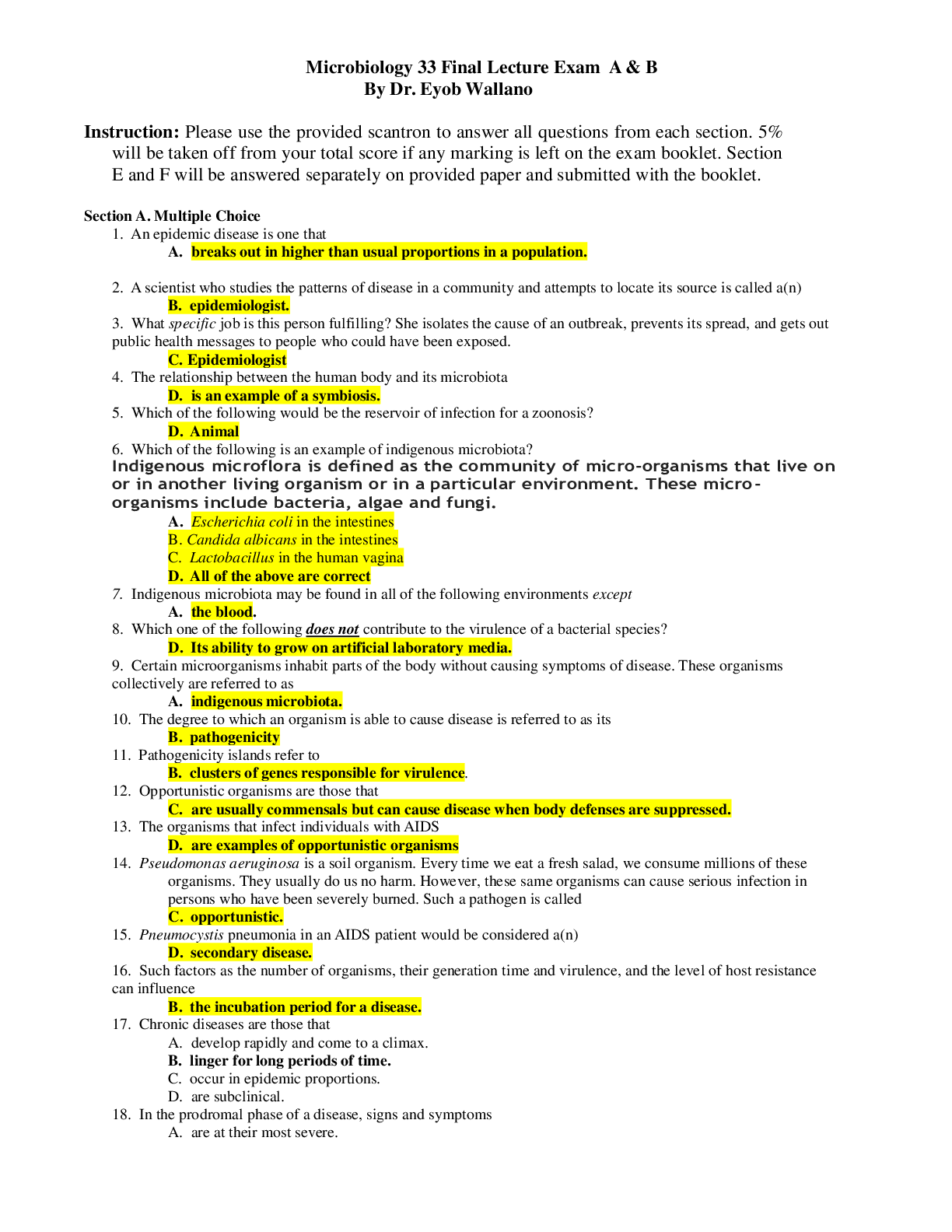
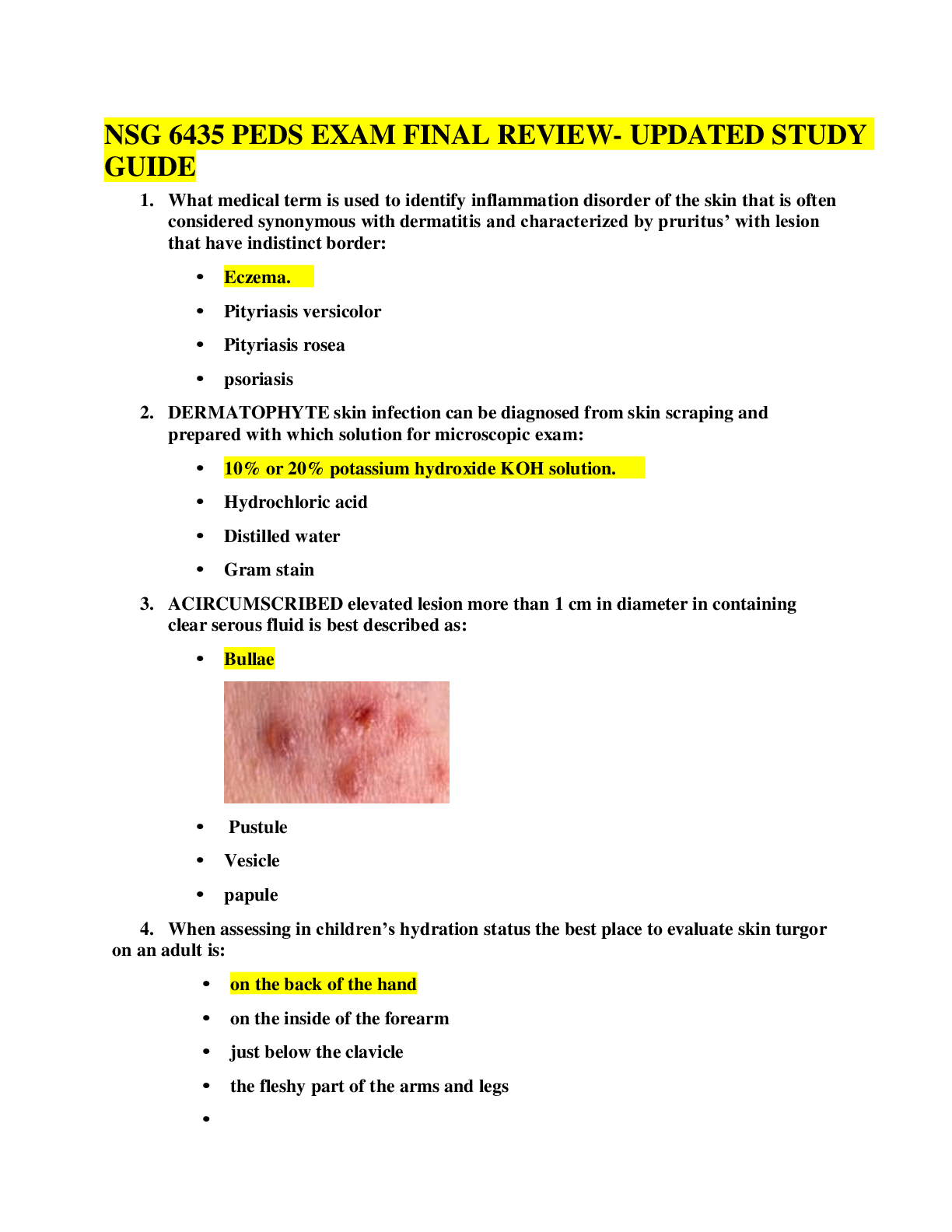




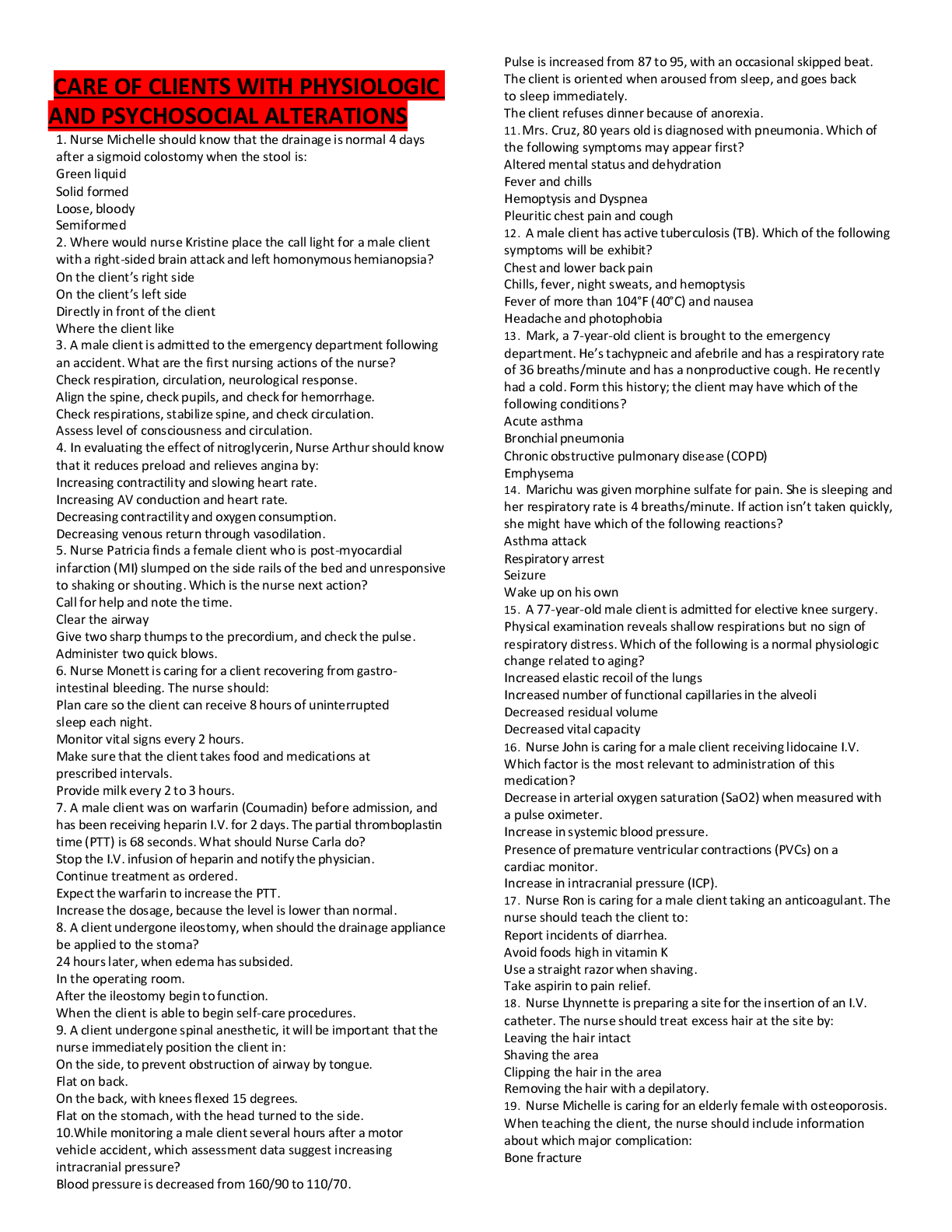



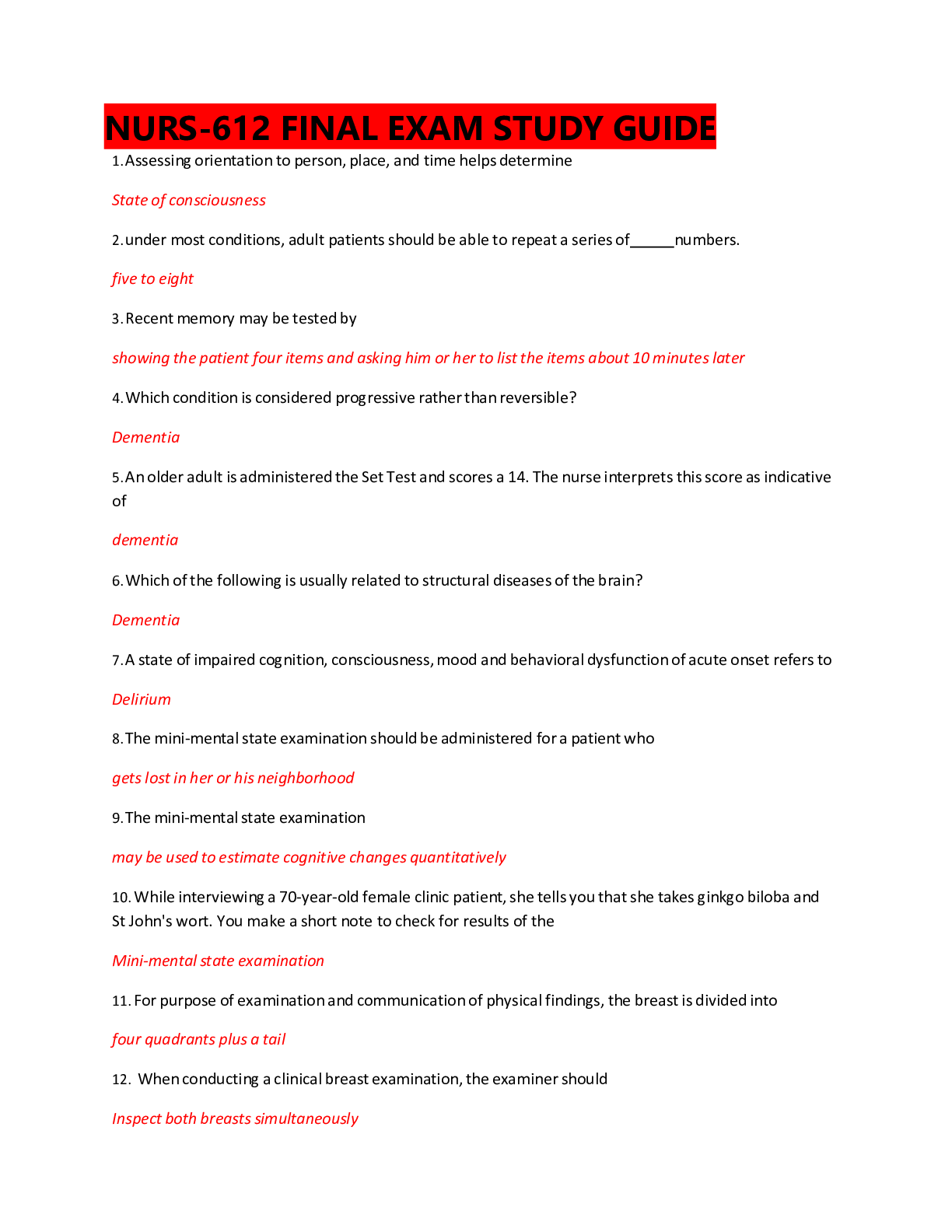
 BMAL 590- QUANTITATIVE RESEARCH TECHNIQUES AND STATISTICS TEST WITH SUMMARIZED STUDY GUIDE.png)
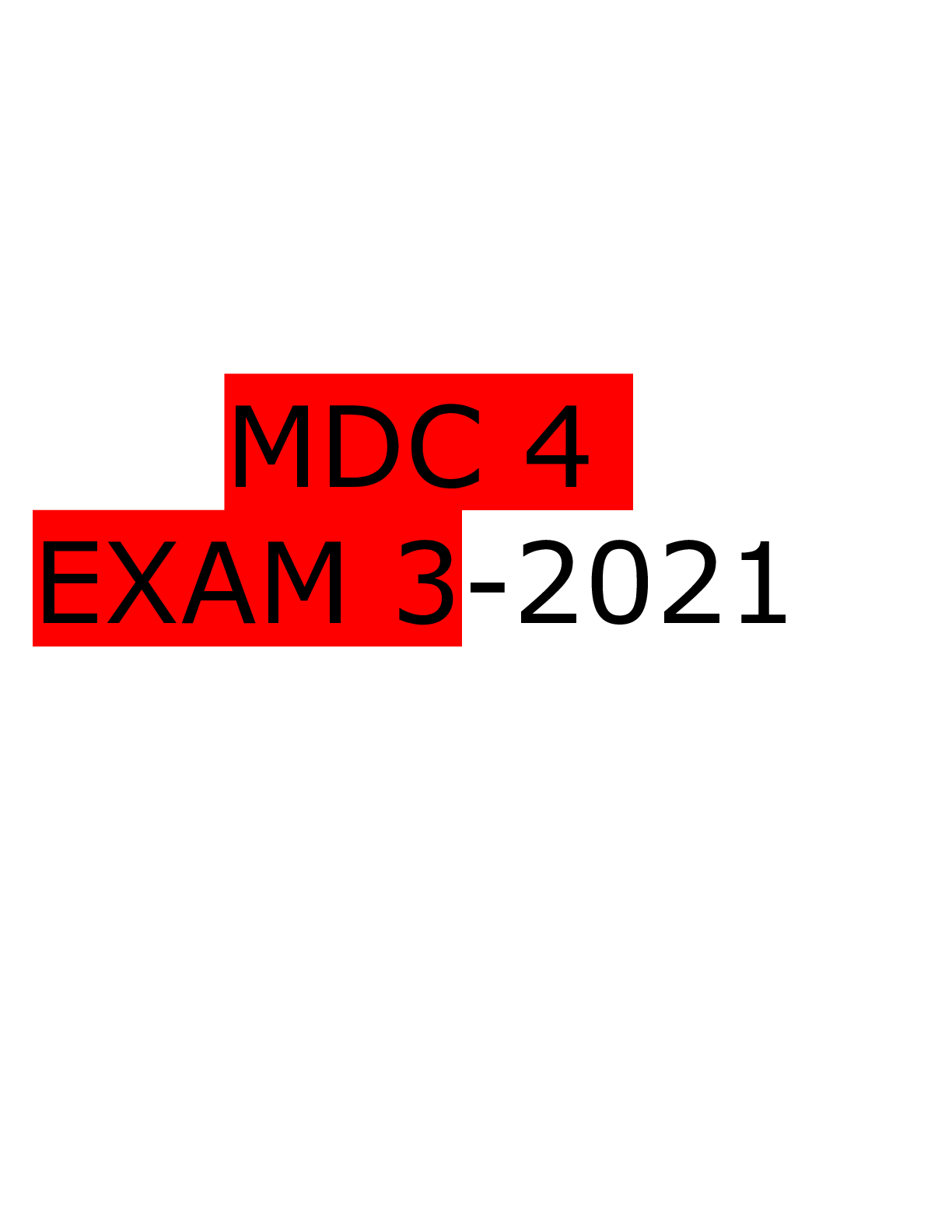
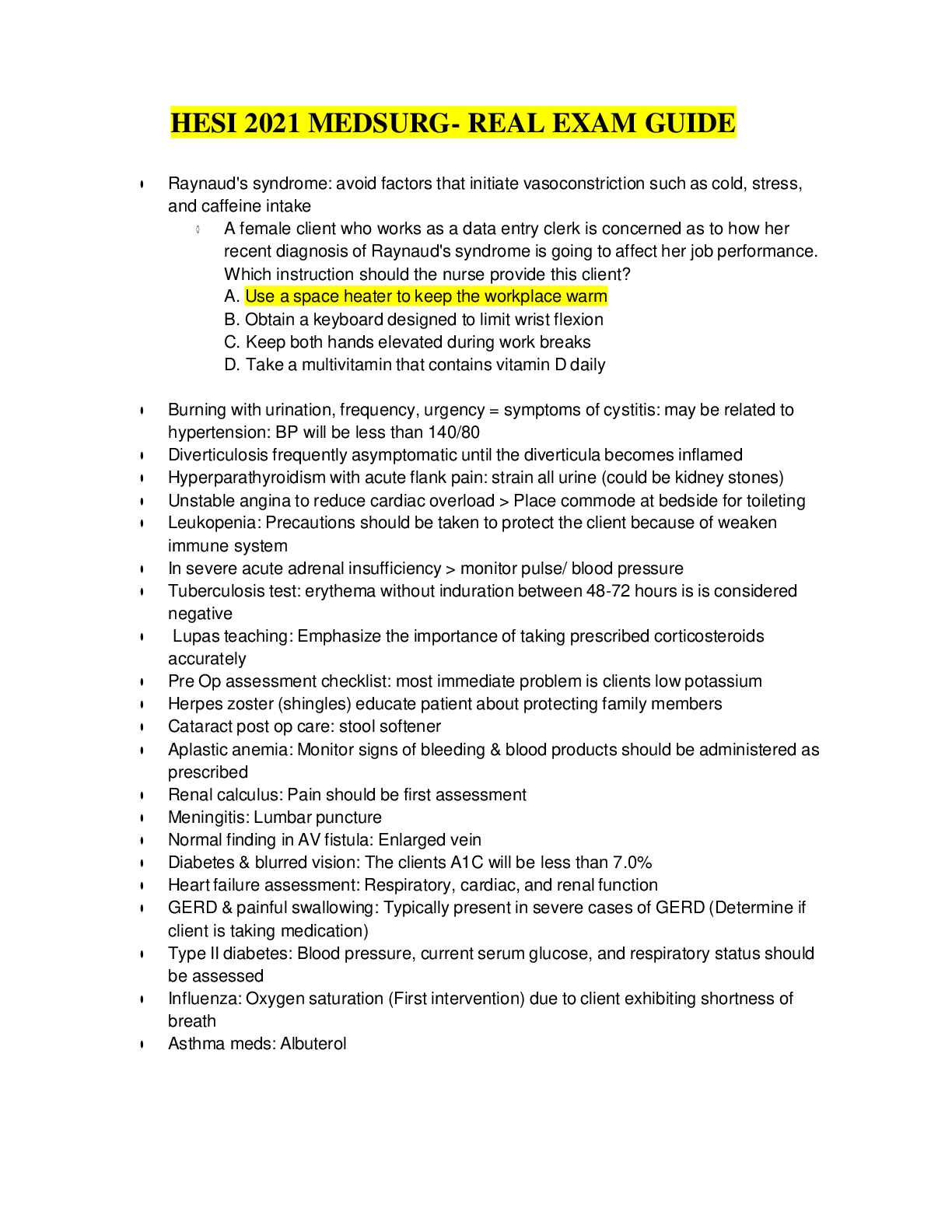


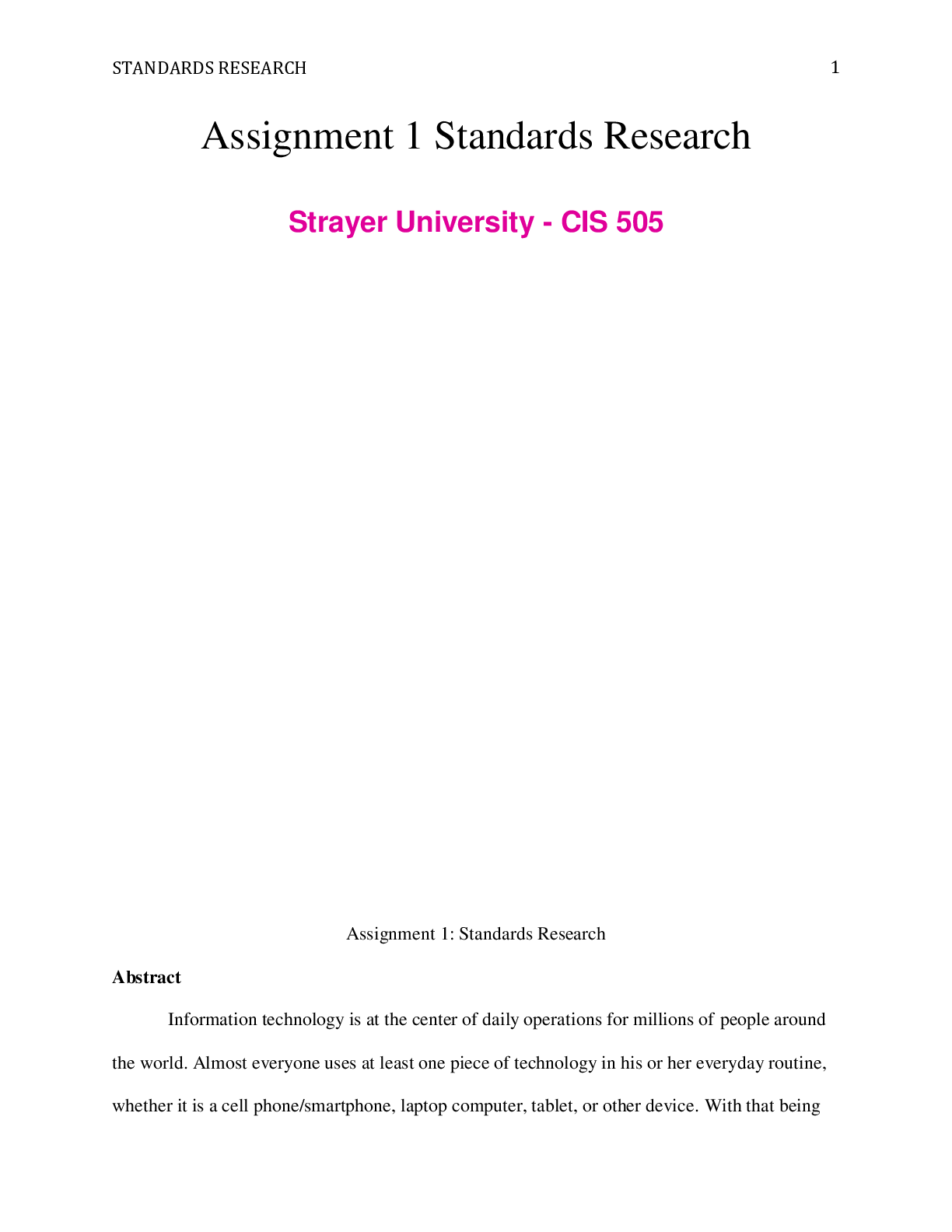
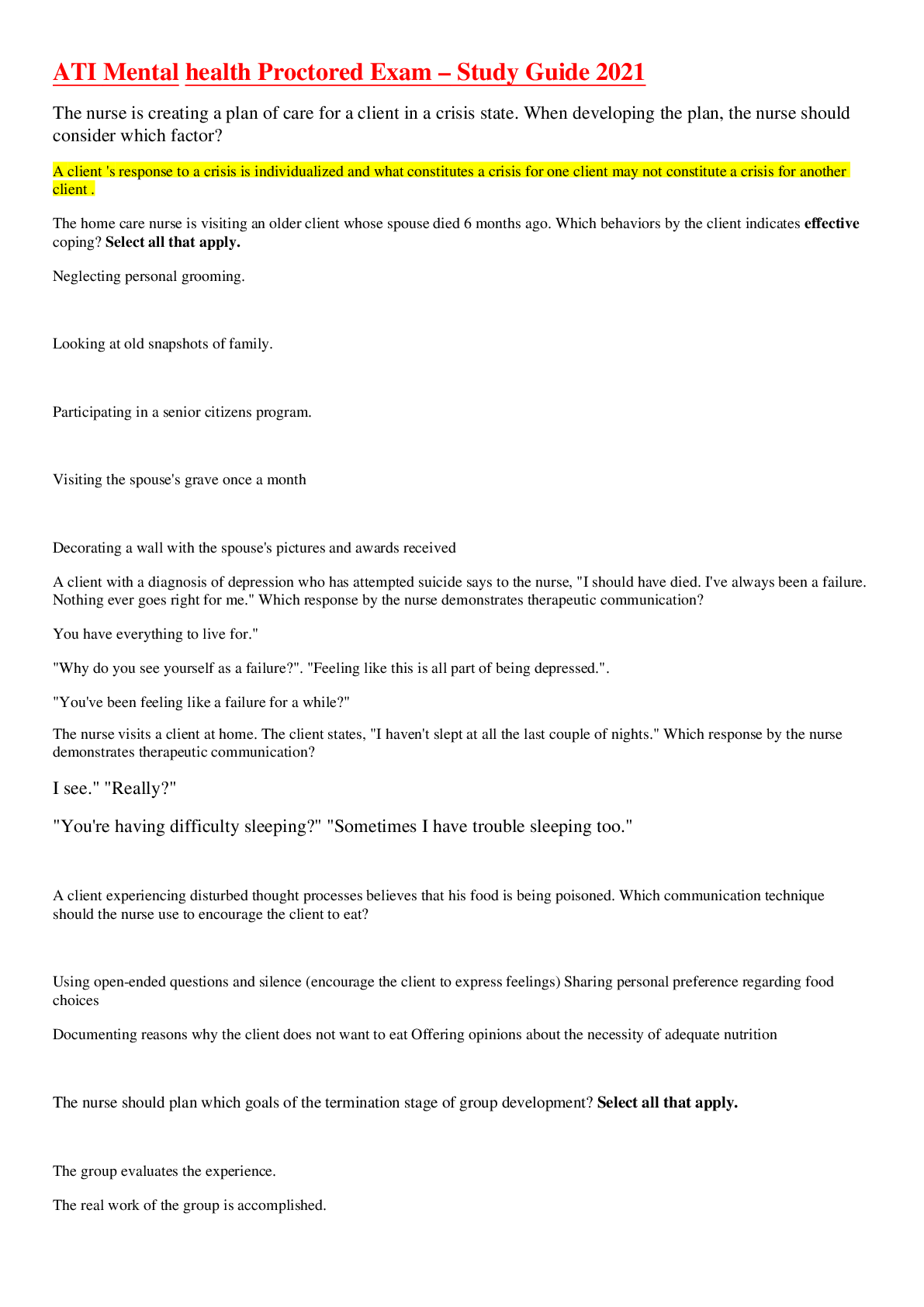

.png)
.png)
